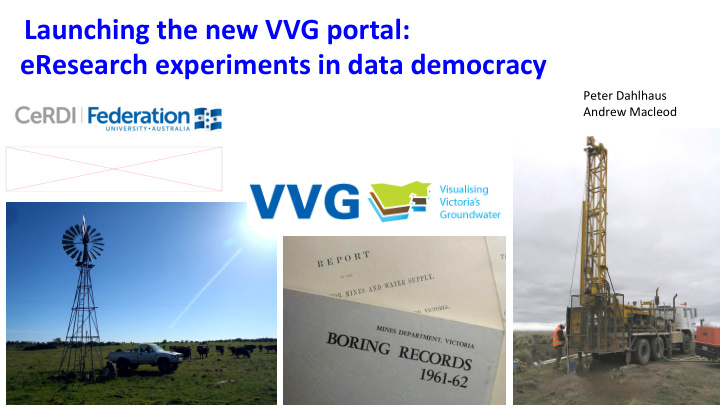



Launching the new VVG portal: eResearch experiments in data democracy Peter Dahlhaus Andrew Macleod
July 2011 granted a Broadband Enabled Innovation Program $320k BEIP cash + $160k partner cash + $1.745M in-kind A collaboration of 17 partner organisations Soft launch June 2012 An interoperative spatial information portal that federates groundwater data from disparate sources. Primarily for research and investigation. Non-government portal (unique?).
www.vvg.org.au Federates around 80 groundwater data sets from 8 custodians. Some data are real-time, some are scheduled updates, some are linked data Depth to watertable
Bore parameters Information on over 400,000 bores accessed from the source databases
Predicted depth to watertable and groundwater quality
3d model of aquifers
EPA audit sites, GQRUZ sites and priority sites
Primary impact The VVG portal is frequently used by a wide cross-section of society Analytics
Practice impact The portal has changed the way people find groundwater data
Sector impact Journal of Hydroinformatics: 18/2 March 2016 (open access) The provision of multiple groundwater datasets from disparate sources within a single internet portal has changed practices in the Victorian groundwater industry.
www.cerdi.edu.au The VVG has spawned around 30 spatial data portals
Data interoperability Full interoperability requires adopting common: systems - communication protocols (e.g. for web services); syntax - representation language (e.g. Extensible Markup Language (XML), JavaScript Object Notation (JSON) or others); structure - data schema (e.g. GWML1); semantics - content vocabulary (e.g. for water quality parameters); and pragmatics - best practices in the collection and use of the data
Open Geospatial Consortium : an international consortium of companies, government agencies and universities that develops publically available international spatial data standards for data interoperability. OGC (R) standards are technical documents that detail interfaces or encodings used by software developers. Groundwater Interoperability Experiment 2 (GW2IE) http://external.opengis.org/twiki_public/HydrologyDWG/GroundwaterInteroperabilityExperiment2 14
GWML2 interoperability experiment Aims: • Develop an international groundwater information model • Develop a GML application schema, for groundwater data • Harmonize existing models (GWML, INSPIRE) Regions: North America Europe Australasia 5 years, 57 meetings
GWML2 interoperability experiment Use Cases Agreed entities Conceptual Schema Logical Schema Physical Schema
Entities : HydrogeoUnits, Voids, Fluid Bodies GW_Basin GW_ManagementArea GW_MonitoringSite Wellfield GW_AquiferSystem Groundwater basin Observation Unconfined aquifer well GW_Aquifer Bedrock Aquifer Well aquifer GW_ConfiningBed Confining bed GW_Aquifer Confined aquifer d e B g n Fractured GW_Aquifer i n i f n o rock aquifer C _ Confining bed W G Groundwater filling the pore space Particulate GW_AquiferUnit rock aquifer GW_FluidBody Solutes, suspended solids, GW_HydrogeoVoid and organisms in groundwater GW_ChemicalConstituent GW_MaterialConstituent GW_BiologicConstituent
Entities : Flow, Well GW_Recharge GW_Discharge Pumping well GW_Discharge GW_Spring GW_Divide GW_BodySurface Land surface GW_Well Groundwater basin Vadose zone Watertable Unconfined aquifer GW_ConfiningBed Confining bed w o GW_Flow l f Ground water Confined aquifer Bedrock aquifer GW_Aquifer GW_IntraFlow GW_InterFlow GW_FlowSystem GW_FlowSystem GW_FlowSystem
simplified UML representation of the GWML2 conceptual schema. Colours denote distinct packages within the logical schema
International data interoperability standards OGC WaterML 2: Part 4 – GroundWaterML 2 (GWML2) Is maintained by a Groundwater Standards Working Group Google OGC GW SWG to find it!
So what constitutes groundwater data? Geomorphology Climate Environmental History Terrain Rainfall Land use Landscape Runoff Soils Infiltration Salinity Discharge Bore construction Recharge Springs Extraction GDEs Water levels Baseflow Storage River flows Lake levels Geology Lithology Stratigraphy Hydrobiology Hydrostratigraphy Phreatophytes Aquifers Stygofauna Aquifer parameters Microbiology Management Flow systems Chemistry Geophysics Beneficial uses Risk Age (dating) Contamination Licences
But what about the qualitative data? Data often overlooked by scientists (hydrogeologists), but it can be critically important. Examples include observations about landscape features, soil colours, vegetation types, seeps, springs, wetland ecosystems, and anecdotal information from long-term occupiers of the land. Redoximorphic features in saprolite, Dundas Tableland, Vic
Original data sources are valuable Archival boring records are particularly important sources of information.
Trends in data custodianship Data volumes Does not include 1970 1990 2010 2020 social data
DATA REGIMES Data Dictatorship: Data is controlled and its use restricted. Distribution of data is based on perceived necessity. Data Aristocracy: Data analysts and scientists are required to provide meaning, and they have the power. Data Anarchy: Users feel underserved and create their own datasets from available sources. Data sharing is ad-hoc. Data Democracy: Everybody gets timey and equitable access to data. Users are empowered and they often own some of the data.
Antle, J.M., Basso, B., Conant, R.T., Godfray, H.C.J., Jones, J.W., Herrero, M., Howitt, R.E., Keating, B.A., Munoz-Carpena, R., Rosenzweig, C., Tittonell, P. and Wheeler, T.R. (2017). Towards a new generation of agricultural system data, models and knowledge products: Design and improvement. Agricultural Systems . DOI:http://dx.doi.org/10.1016/j.agsy.2016.10.002.
Data Democracy can interoperably federate: ✓ Public and private data ✓ Big data, sensors, internet of things ✓ Legacy data ✓ Crowdsourced data To answer the frequently asked hydrogeological questions To dynamically generate conceptual and predictive models To make new discoveries and avoid repeating past mistakes To reduce time wasted in litigious conflicts
beta.vvg.org.au
Recommend
More recommend